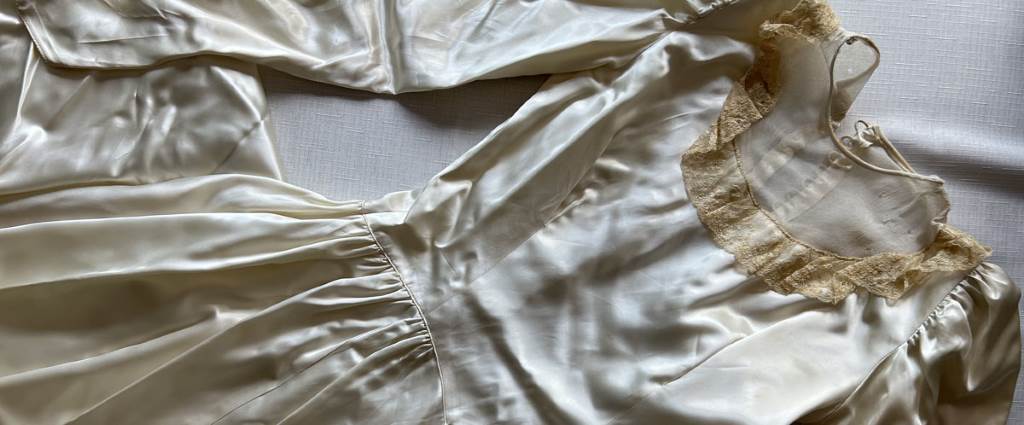How to make sure your clinic looks professional
July 21, 2025
Bra Alternatives for Developing Tans
August 5, 2025Antique silk dresses are timeless treasures, embodying history, craftsmanship, and elegance. Whether inherited or acquired from a vintage boutique like Kate Spade Star, these delicate garments require meticulous care to maintain their beauty and structural integrity. Silk, a natural fiber, is prone to degradation over time, but with proper preservation techniques, you can ensure these heirlooms remain vibrant for future generations. This guide provides practical, people-first advice on preserving antique silk dresses, covering storage, cleaning, handling, and more.
Table of Contents
ToggleUnderstanding Antique Silk Dresses
Antique silk dresses, often from the 18th to early 20th centuries, are delicate due to their age and the natural properties of silk. Silk is sensitive to light, humidity, temperature, and physical stress, which can cause fading, yellowing, or fabric weakening. Therefore, preserving these garments starts with understanding their vulnerabilities. For instance, if you’re curating a london outfit for a vintage-inspired event, ensuring the dress remains in pristine condition is crucial. Proper care not only maintains aesthetic appeal but also preserves historical value.
Storage Solutions for Antique Silk Dresses
Proper storage is the cornerstone of preserving antique silk dresses. Improper conditions can accelerate deterioration, so consider the following steps:
- Use Acid-Free Materials: Store dresses in acid-free tissue paper and boxes to prevent chemical reactions that degrade silk. Avoid regular cardboard or plastic, which can emit harmful gases.
- Avoid Hanging: Hanging can stress seams and cause stretching. Instead, lay the dress flat in a box, folding minimally with acid-free tissue supporting folds.
- Control Environment: Store in a cool, dry, dark place with stable temperature (around 65-70°F) and humidity (40-50%). Avoid attics or basements prone to dampness.
- Protect from Pests: Use cedar blocks or lavender sachets to deter moths, avoiding direct contact with the fabric to prevent staining.
Additionally, check stored dresses every 6-12 months to ensure no mold, pests, or discoloration has developed. Museums like the Victoria and Albert Museum recommend similar practices for textile preservation.
Cleaning Antique Silk Dresses
Cleaning antique silk is risky due to its fragility. Never machine-wash or soak these dresses, as water and agitation can weaken fibers. Instead, follow these guidelines:
- Spot Cleaning: For small stains, consult a professional conservator. If attempting at home, use a dry, soft cloth to gently dab—never rub—the area.
- Avoid Water-Based Cleaners: Water can cause silk to shrink or lose its sheen. Dry cleaning by a specialist in vintage textiles is safer.
- Test First: If using any cleaning agent, test it on an inconspicuous area, like an inner seam, to ensure it doesn’t damage the fabric.
For complex cases, consult experts like those at The Textile Conservation Centre. Their expertise ensures safe cleaning without compromising the dress’s integrity.
Handling and Displaying Antique Silk Dresses
Handling antique silk dresses requires care to avoid physical damage. Always wash and dry hands thoroughly or wear clean, white cotton gloves to prevent oil transfer. Additionally, avoid wearing jewelry or accessories that could snag the fabric. When displaying for events or exhibitions, consider these tips:
- Limit Light Exposure: Ultraviolet (UV) light fades silk. Use UV-filtering glass cases or low-wattage lighting for short-term displays.
- Use Proper Mannequins: Choose padded, archival-quality mannequins to avoid stressing seams. Ensure the mannequin matches the dress’s original size to prevent stretching.
- Rotate Displays: Limit display time to a few months, then return the dress to storage to minimize environmental exposure.
Moreover, avoid frequent handling, as each touch increases wear. If showcasing a dress for a special occasion, handle it minimally and store it promptly afterward.
Repairing Antique Silk Dresses
Repairs on antique silk dresses should be approached cautiously to avoid further damage. Common issues include tears, loose seams, or missing beads. Here’s how to proceed:
- Consult Professionals: A textile conservator can stabilize tears using techniques like stitching with silk thread or applying adhesive patches.
- Avoid DIY Repairs: Standard sewing can cause more harm, as modern threads may be too strong for fragile silk.
- Preserve Originality: Repairs should aim to stabilize, not alter, the dress’s historical features.
Regular inspections can catch issues early, preventing the need for extensive repairs. Document any repairs for future reference, noting materials and methods used.
Preventing Common Damage
Prevention is key to preserving antique silk dresses. Several factors can cause irreversible damage if not addressed:
- Light Damage: Prolonged exposure to sunlight or artificial light fades colors. Store dresses in dark environments and use light-blocking curtains if displayed.
- Humidity and Mold: High humidity encourages mold growth. Use silica gel packets in storage boxes to absorb excess moisture.
- Insect Infestation: Moths and beetles can destroy silk. Inspect regularly and use non-chemical deterrents like cedar or lavender.
- Chemical Exposure: Avoid perfumes, hairsprays, or cleaning agents near the dress, as these can stain or weaken fibers.
By proactively addressing these risks, you can significantly extend the life of your antique silk dress.
Read Also:
Best Fashion Stores in Roosevelt Island: Your Ultimate Shopping Guide
Best Fashion Stores in Brooklyn for Unique Style in 2025
Long-Term Preservation Strategies
For long-term preservation, consider creating a preservation plan. Document the dress’s condition, including photographs, measurements, and notes on any damage or repairs. This record helps track deterioration over time. Additionally, consider insuring valuable pieces, especially if they hold significant historical or monetary value. Finally, educate yourself on textile conservation through resources like museum websites or workshops to stay informed about best practices.
FAQs
How often should I check my stored antique silk dress?
Inspect every 6-12 months for signs of mold, pests, or fabric degradation. Ensure storage conditions remain stable.
Can I display my antique silk dress at home?
Yes, but limit light exposure, use UV-filtering cases, and rotate displays every few months to minimize damage.
Is it safe to dry clean an antique silk dress?
Only use a dry cleaner specializing in vintage textiles. Standard dry cleaning may damage delicate silk.
What should I do if my silk dress has a tear?
Consult a textile conservator for professional repair. Avoid DIY fixes, as they can worsen the damage.
How can I prevent moths from damaging my silk dress?
Use cedar blocks or lavender sachets in storage, avoiding direct contact. Regularly inspect for signs of pests.
Conclusion
Preserving antique silk dresses requires dedication, but the reward is maintaining a piece of history for future enjoyment. By using acid-free storage, handling with care, and consulting professionals for cleaning and repairs, you can protect these delicate garments from deterioration. Moreover, proactive measures like controlling light, humidity, and pests ensure longevity. Whether you’re safeguarding a family heirloom or a vintage find, these steps will keep your antique silk dress as stunning as the day it was made.
Warning: Trying to access array offset on null in /home/todayd5097/public_html/wp-content/themes/betheme/includes/content-single.php on line 286


